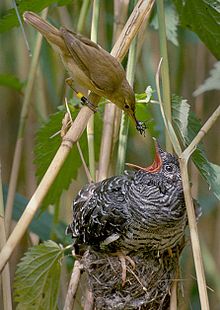Fixed action pattern: Difference between revisions
sorry |
No edit summary |
||
| Line 11: | Line 11: | ||
Other examples include: |
Other examples include: |
||
*[[Kelp Gull]] chicks are stimulated by a red spot on the mother's beak to peck at spot, which induces regurgitation. |
*[[Kelp Gull]] chicks are stimulated by a red spot on the mother's beak to peck at the spot, which induces regurgitation. |
||
*Some [[moth]]s instantly fold their wings and drop to the ground if they encounter ultrasonic signals such as those produced by [[bat]]s; see [[ultrasound avoidance]]. |
*Some [[moth]]s instantly fold their wings and drop to the ground if they encounter ultrasonic signals such as those produced by [[bat]]s; see [[ultrasound avoidance]]. |
||
Revision as of 17:53, 20 February 2012

In ethology, a fixed action pattern (FAP), or modal action pattern, is an instinctive behavioral sequence that is indivisible and runs to completion.[1] Fixed action patterns are invariant and are produced by a neural network known as the innate releasing mechanism in response to an external sensory stimulus known as a sign stimulus or releaser (a signal from one individual to another). A fixed action pattern is one of the few types of behaviors which can be said to be hard-wired and instinctive.
Examples

Many mating dances, commonly carried out by birds, are examples of fixed action patterns. In these cases, the sign stimulus is typically the presence of the female.
Another example of fixed action patterns is aggression towards other males during mating season in the red-bellied stickleback. A series of experiments carried out by Niko Tinbergen showed that the aggressive behavior of the males is a FAP triggered by anything red, the sign stimulus. The threat display of male stickleback is also a fixed action pattern triggered by a stimulus.
Another well known case are the classic experiments by Tinbergen and Lorenz on the Graylag Goose. Like similar waterfowl, it will roll a displaced egg near its nest back to the others with its beak. The sight of the displaced egg triggers this mechanism. If the egg is taken away, the animal continues with the behavior, pulling its head back as if an imaginary egg is still being maneuvered by the underside of its beak.[2] However, it will also attempt to move other egg shaped objects, such as a golf ball, door knob, or even an egg too large to have possibly been laid by the goose itself (a supernormal stimulus).[3]
Other examples include:
- Kelp Gull chicks are stimulated by a red spot on the mother's beak to peck at the spot, which induces regurgitation.
- Some moths instantly fold their wings and drop to the ground if they encounter ultrasonic signals such as those produced by bats; see ultrasound avoidance.
- Mayflies drop their eggs when they encounter a certain pattern of light polarization which indicates they are over water.
Significance
A FAP is significant in animal behavior because it represents the simplest type of behavior, in which a readily defined stimulus nearly always results in an invariable behavioral response. A FAP can truly be said to be "hard-wired." FAPs are also unusual, in that most behaviors are modulated by the environment; a fixed response can lead to maladaptive results, whereas flexible behaviors are generally more useful. Because of this, most behaviors which are both FAPs and occur in more complex animals are usually essential to the animal's fitness or in which speed is a factor. For instance, the Greylag Goose's egg rolling behavior is so essential to the survival of its chicks that its fitness is increased by this behavior being hard-wired. A chick which cannot consistently feed will die. A moth's response to encountering echolocation needs to be immediate in order to avoid predation. An attacking stickleback is placed at an advantage if it reacts quickly to a threat. However, because these behaviors are hard-wired, they are also predictable. This can lead to their exploitation by humans or other animals.
Exploitation

Some species have evolved to exploit the fixed action patterns of other species by mimicry of their sign stimulus. Replicating the releasing mechanism required to trigger a FAP is known as code-breaking. A well known example of this is brood parasitism, where one species will lay its eggs in the nest of another species, which will then parent its young. A young North American cowbird, for example, provides a supernormal stimulus to its foster parent, which will cause it to forage rapidly in order to satisfy the larger bird's demands.[4] In a natural situation a nestling will provide higher levels of stimulus with noisier, more energetic behavior, communicating its urgent need for food. Parents in this situation should work extra hard to provide food, otherwise their own offspring are likely to die of starvation.
References
Cited
- ^ Campbell, N. A. (1996) Biology (4th edition), Chapter 50. Benjamin Cummings, New York ISBN 0-8053-1957-3
- ^ Video of Grelag Goose performing FAP
- ^ Tinbergen, N. (1951) The Study of Instinct. Oxford University Press, New York.
- ^ Wickler, W. (1968) Mimicry in Plants and Animals. World University Library, London.
General
- Alcock, J. (1998) Animal Behavior: An Evolutionary Approach (6th edition), Chapter 5. Sinauer Associates, Inc. Sunderland, Massachusetts. ISBN 0-87893-009-4
- James E. Mazur (2005) Learning and Behavior, (6th Edition]. New Jersey: Prentice Hall. ISBN 978-013-193163-3
